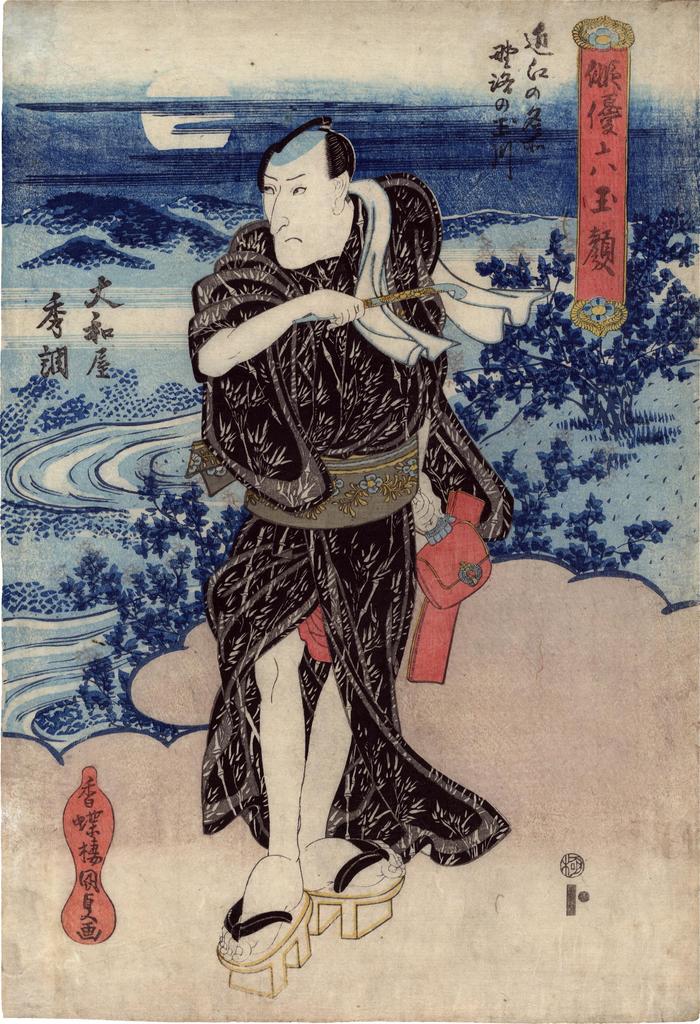Utagawa Kunisada (歌川国貞) / Toyokuni III (三代豊国) (artist 1786 – 01/12/1865)
Bandō Mitsugorō IV (坂東三津五郎) as Yamatoya Shuchō (大和屋秀調) and the Noji no Tamagawa (野路の玉川), a famous place in Omi Province (近江の名所) from the series 'Actors with Six Jewel Faces' (Haiyū mutama-gao - 俳優六玉顔)
ca 1832
10.25 in x 15 in (Overall dimensions) Japanese color woodblock print
Signed: Kōchōrō Kunisada ga
香蝶楼国貞画
Publisher: Yamaguchiya Tōbei
(Marks 591 - seal 15-005)
Censor's seal: kiwame
Waseda University
Lyon Collection - Yamatoya Baiga from this series
Nationaal Museum van Wereldculturen, Leiden via Ritsumeikan University
Ishikawa Prefectural Museum
Lyon Collection - Nakamura Shikan II from this series
Lyon Collection - Bandō Hikosaburō IV from this series
Victoria and Albert Museum "The Six Jewel Rivers were noted beauty spots of antiquity. The title of Kunisada's series - 'Actors with Six Jewel Faces' - is a pun on the words kawa (river) and kao (face). The popularity of the untitled set of ten landscapes published by Kinkōdō... and the interest in landscape prints in general, encouraged Kunisada to continue to design them, although he used his specialty, portraits of actors and beauties, as a foreground and main subject. In the landscape background he took advantage of the vogue for prints in shades of blue (aizuri-e)....
Yamatoya Shuchō (Bandō Minosuke II, Morita Kanya XI, 1802-1863)... assumed the name Bandō Mitsugorō IV shortly after the death of his adoptive father, Mitsugorō III, in 1831. He was particularly noted as the male lead in contemporary domestic dramas and for his talents as a dancer. The rivalry between his father and Nakamura Utaemon III... was continued by their sons, who competed for preeminence until the death of Utaemon IV in 1852. In the final years of his life Shuchō retired from acting and took over the management of the Morita theater. Here he is seen wearing a loose, transparent summer robe with a hand towel slung over his shoulder. He carries a pipe in one hand and a tobacco pouch and pipe case in the other. The blue landscape background features the bush clover for which this locale was famous."
Quoted from: Kunisada's World by Sebastian Izzard, p.142. Illustrated as cat. #66/2.
****
Illustrated
1) in color in Ukiyo-e Masterpieces in European Collection 5: Victoria and Albert Museum II, Kodansha, 1989, #13.
2) in black and white in Kunisada's World by by Sebastian Izzard, p.142, #66/2.
****
The aizuri-e background in this print with a full moon and bush clover is based on a poem by Minamoto no Toshiyori (源俊頼: 1055-1129).
Yamaguchiya Tōbei (山口屋藤兵衛) (publisher)
actor prints (yakusha-e - 役者絵) (genre)
blue prints (aizuri-e - 藍摺絵) (genre)
Bandō Mitsugorō IV (四代目坂東三津五郎: from 3/1832 to 10/1850) (actor)
landscape prints (fūkeiga 風景画) (genre)
